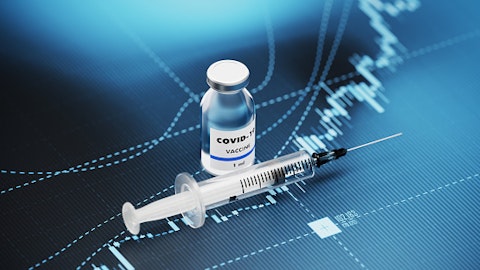Michael Yee: Hi, guys. Thank you for the question, and congrats on a great quarter. We had a follow-up question on pain and then a question on vanza. On the acute and chronic pain, can you just remind me, since you’ve never disclosed doses, should we expect that it’s the same doses used in the Phase 2 and also the Lyrica and Vicodin doses as a control, or basically the doses from the label, and is that pretty well understood? And then from a safety tolerability standpoint, I think there was a QT study that had completed, so was there anything to disclose there? That would be great to hear if that was the case. That’d be a positive. And then on VANS, I know that there was questions around non-inferiority and superiority, and I know it’s power potentially for superiority, but can you just remind us, is there a magnitude of clinical meaningfulness on FEV, et cetera, that you would deem to be meaningful, or is it more the totality of everything as well, like sweat chloride and the benefits that that may provide?
Thank you so much.
Reshma Kewalramani: Sure thing. Hey, Mike, let me start, and then I will ask Stuart to go over the research that Stuart and the team have done on vanza and what is valued vis-a-vis sweat chloride, etc. But I’ll go back to 548 to start and then I’ll set up the clinical trial structure for vanza. So to confirm, on the VX-548 acute pain phase 3 trials. It is exceptionally similar to the VX548 Phase 2 trials. Same pain conditions, abdominoplasty and bunionectomy. We selected the high dose, the dose that showed the benefit in the Phase 2 trial for the Phase 3 trial. And you are correct, standard labeled doses for the opioid. And on the Phase 2 diabetic peripheral neuropathy trial, correct, the Lyrica’s standard doses from the label.
The doses in the peripheral neuropathy phase 2 study are different than the acute pain doses, obviously, because one has chronic dosing and one is acute, And we need to make the appropriate adjustments so that we have the exposure we seek. But with regard to the reference arm, correct. It is the standard dosing from the label. Lastly, on vanzacaftor, remember, this is a study that is head-to-head versus Trikafta. The primary endpoint is PPF-EV1, because that’s the regulatory enabling endpoint. And recall, we have a key secondary endpoint that is on SWEC chloride, and this is very important because SWEC chloride is the direct, it’s the most direct readout of CFTR function. You know that there have been great debates about whether or not there is a ceiling on ppF-EV1.
We can’t have better than normal lung function, right? But in terms of sweat chloride, that is how patients are diagnosed with the disease. And it is very well understood that if we provide better CFTR function benefit, that would show up in terms of sweat chloride. That is a secondary endpoint in the Phase 3 trial. And that’s what we’ve already studied and reported out in a variety of Phase 2 trials. And it does indeed look to be the case that the vanza triple is even better than, I know that’s a tall order, but it’s even better than TRIKAFTA. Over to you Stuart on the marketplace with that in mind.
Stuart Arbuckle: Yeah so Mike, just as Reshma said on the study, the primary end point is non-inferiority versus TRIKAFTA on FEV1, which as we know is an incredibly high bar, but we will be able to see you how vancicafeter does versus tricafter in the study. So that’s the first thing just to remind you. As Reshma said, we’re also looking at measures of superior CFTR function in patients. And when we’ve done research with physicians, even if the FEV1 benefit is the same with vanzacaftor. If we can demonstrate improved CFTR function, which as Reshma said, the pharmacodynamic measure of that is sweat chloride, there’s a lot of enthusiasm from physicians for a product which has that profile. In addition, just to remind you, vanzacaftor is also going to be a once a day regimen as well, which is also considered to be of benefit, particularly for those patients who have compliance challenges as well.





